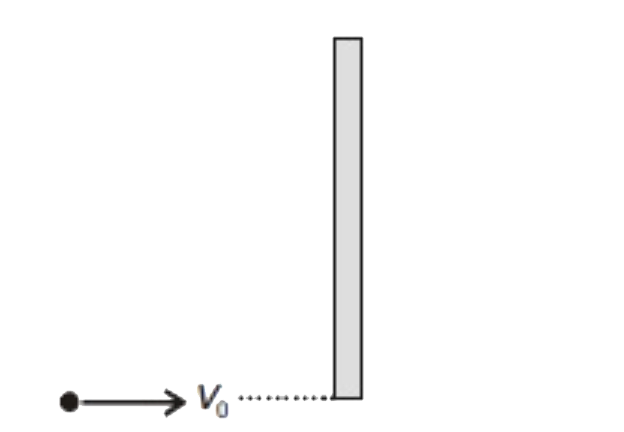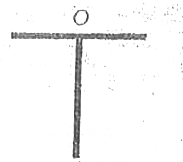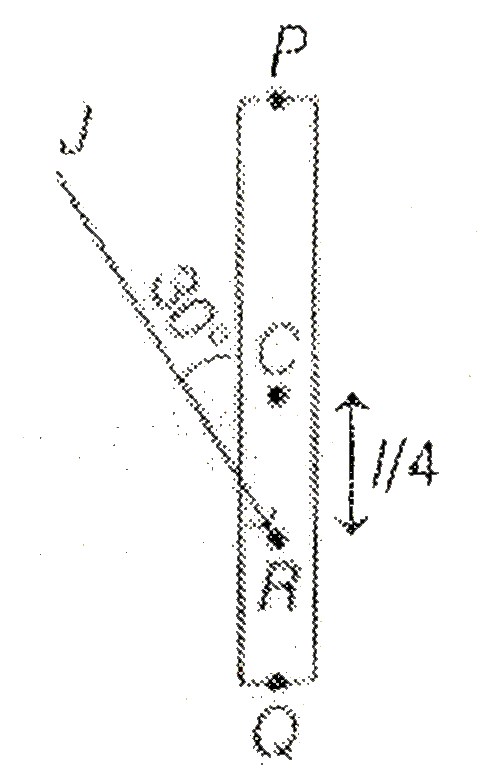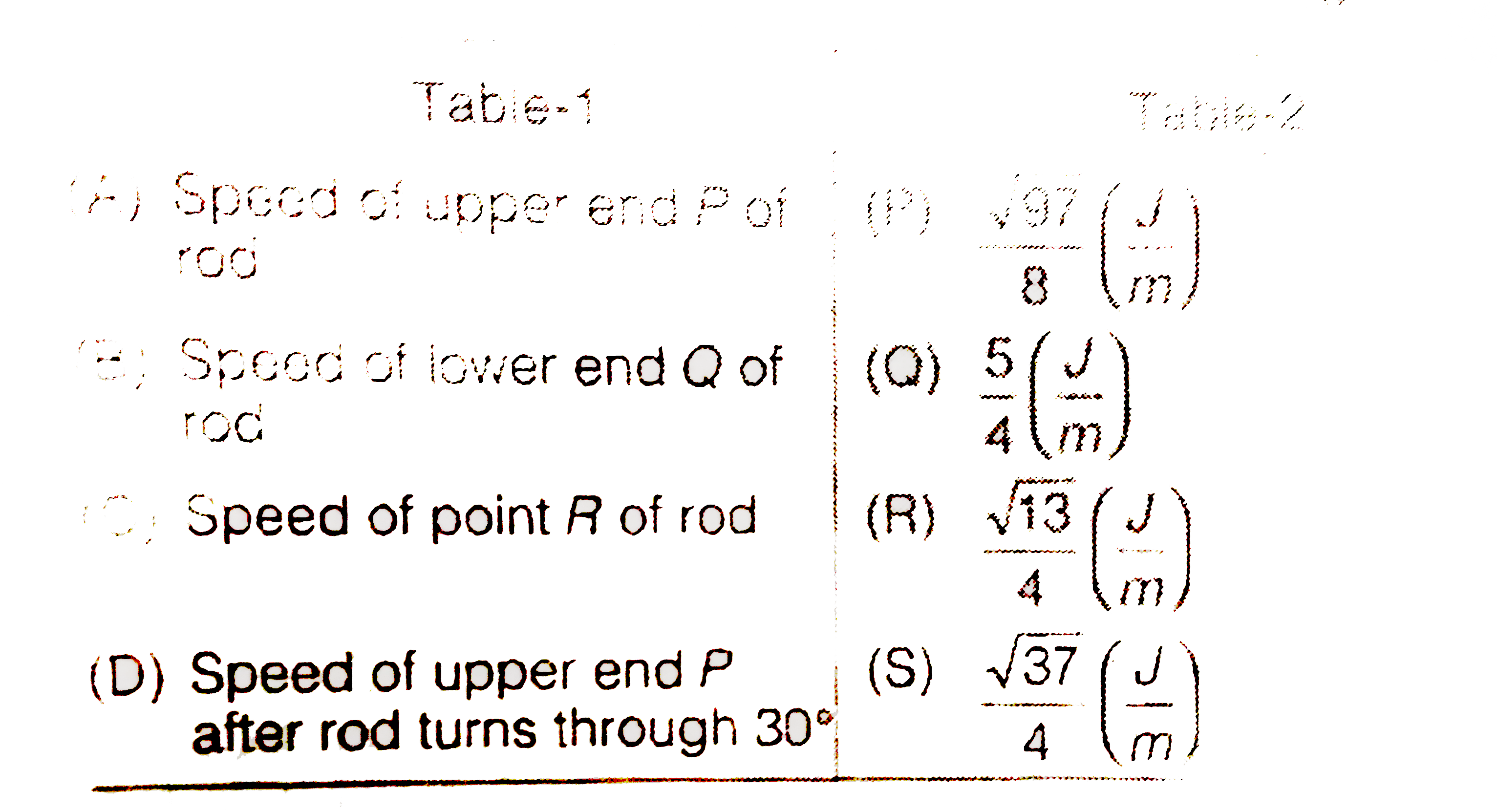A uniform thin rod AB of mass M and length l stands at the edge of a frictionless table as shown in the figure. A particle of mass m = M/2 flying horizontally with a velocity v0 strikes the rod at its top edge A and sticks to it. The rod is immediately driven off the table. Determine

(a) velocity of centre of mass of the system (rod + particle) just after collision between M and m.
(b) position of centre of mass of the system. (Take edge of table at origin).
(c) angular velocity of the system about centre of mass.
(d) the position of the centre of mass of the system when it rotates by 180∘ (Take v0=π m/s and l = 1 m)
(e) at t = 1.5 sec, rod hits the horizontal plane at depth H below the table. Find H and coordinate of edge B of the rod just before striking the ground. (take g = 10 m/s2)
(a) Applying conservation of momentum.
mv0=(M+m)v
⇒ v=M2v0(3M/2)=v03⇒v=v03

(b) Centre of mass is taking as lower edge in contact with the table as origin
y=(Ml2+Ml2)/3M2=2Ml3M=2l3
(c) Applying conservation of angular momentum of the system about C,
M2v0l3=Iω=[Ml212+M(l6)2+M2(l3)2]ω
⇒ M2v0l3=Ml26ω
⇒ ω=v0l

(d) ωt=π(forθ=180∘)
t=πω
t=πlv0
∴ t=1sec
∴ x-coordinate difference x = vt = v03.1=π3 m and
y-coordinate = (23−12×10×12)=−133m
(e) θ=ωt=v0l×1.5⇒θ=3π2
∴ Rod hits the plane horizontally.
2l3+H=12gt2=5×(32)2⇒H=11.25−23=10.58m
xcm=vt=π3×32=π2m
x-coordinate of B =(π2−23) and y-coordinate of B = - 10.58 m

Topper's Solved these Questions
- BOOK - FIITJEECHAPTER - ROTATIONAL MECHANICSEXERCISE - SOLVED PROBLEMS (OBJECTIVE)14videos
ROTATIONAL MECHANICS
- BOOK - FIITJEECHAPTER - ROTATIONAL MECHANICSEXERCISE - ASSERTION REASONING TYPE1videos
ROTATIONAL MECHANICS
- BOOK - FIITJEECHAPTER - ROTATIONAL MECHANICSEXERCISE - COMPREHENSION - IV2videos
ROTATIONAL MECHANICS
- BOOK - FIITJEECHAPTER - PHYSICS PART2EXERCISE - Numerical Based Question Decimal Type6videos
PHYSICS PART2
- BOOK - FIITJEECHAPTER - SEMICONDUCTOR AND DEVICEEXERCISE - SOLVED PROBLEMS Objective: Level-I20videos
SEMICONDUCTOR AND DEVICE
Similar Questions
A uniform rod of mass m and length L is at rest on a smooth horizontal surface. A ball of mass m, moving with velocity v0, hits the rod perpendicularly at its one end and sticks to it. The angular velocity of rod after collision is
 View Solution
View SolutionA uniform rod of mass M and length L lies on a frictionless horizontal plane. A particle of same mass M moving with speed v0 perpendicular to the length of the rod strikes the end of the rod and sticks to it. Find the velocity of the center of mass and the angular velocity about the center of mass of (rod + particle) system.
View Solution
Knowledge Check
- Question 1 - Select One
A uniform rod of mass m and length L is at rest on a smooth horizontal surface. A ball of mass m, moving with velocity v0, hits the rod perpendicularly at its one end and sticks to it. The angular velocity of rod after collision is
 A6v05LB12v05LC2v05LD3v07L
A6v05LB12v05LC2v05LD3v07L - Question 2 - Select One
A thin rod of mass m and length l is hinged at the lower end to a level floor and stands vertically. Then its upper end will strike the floor with a velocity given by:
A√2glB√3glC√5glD√mgl
Two uniform thin rods each of length L and mass m are joined as shown in the figure. Find the distance of centre of mass the system from point O
 View Solution
View SolutionTwo uniform thin rods each of length L and mass m are joined as shown in the figure. Find the distance of centre of mass the system from point O
 View Solution
View SolutionA rod of mass M and length L is kept on a frictionless horizontal floor. A particle of mass m moving perpendicular to the rod with a speed v strikes at the end of the rod and sticks there. Calculate angular velocity acquired by the combined system.
View SolutionA uniform rod of mass m and length l is lying on a smooth table. An impulse J acts on the rod momentarily as shown in figure at point R. Just after that:

 View Solution
View SolutionA uniform rod of mass m and length l is lying on a smooth table. An impulse J acts on the rod momentarily as shown in figure at point R. Just after that:

 View Solution
View SolutionA thin rod of mass m and length l is hinged at the lower end to a level floor and stands vertically. Then its upper end will strike the floor with a velocity given by:
View Solution

